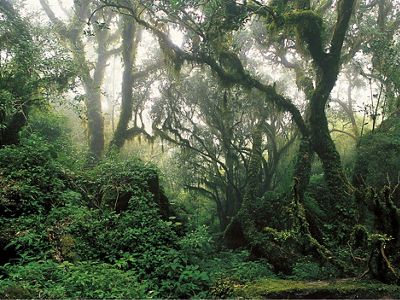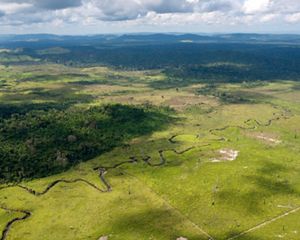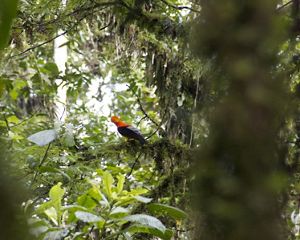
Nature Needs Latin America’s Leadership This Decade
Our region will play a key role in tackling the climate and biodiversity crises—and regenerative agriculture can help.
By Ian Thompson, Executive Director, TNC Brazil
Latin America is home to nearly half the planet's biodiversity, making the region vital to addressing two urgent tasks: reversing the decline of nature and halting climate change. The next decade will be a crucial time for action if we are to avoid tipping points that could have dire consequences for all life on Earth.
However, some fear environmental conservation and climate action will hinder economic development. Nothing could be further from the truth, and The Nature Conservancy (TNC) has the scientific data and real, on-the-ground examples to prove it.
Across sectors and geographies, nature-based solutions are often the most cost-efficient investment for reducing the effects of climate change, improving biodiversity and encouraging sustainable growth—and regenerative agriculture practices exemplify this happy coincidence. Successful projects in Mexico, Central America, Argentina, Colombia, and Brazil—led by TNC in partnership with thousands of producers—demonstrate that food production actually benefits when managed with respect for the delicate ecological balance upon which it depends.

Seeing Nature’s Value in Brazil’s Atlantic Forest
One example of how it's possible to reconcile development and conservation is the Mantiqueira Range Conservation Project in Brazil's Atlantic Forest. This magnificent forest was once a mighty landscape of 304 million acres—twice the size of Texas—but centuries of agriculture, urbanization, and cattle ranching have taken their toll. Today, only about seven percent remains, much of it in small, degraded patches. Even though it is now one of the world's most threatened forests, it remains the habitat of 1,000 types of birds, over 750 reptile and amphibian species, and 23,000 varieties of plants.
The Mantiqueira Range is about the size of Portugal and extends over 284 municipalities in three economic powerhouse states of Brazil: São Paulo, Minas Gerais, and Rio de Janeiro, which together produce nearly half of the country's GDP. The Mantiqueira Range region encompasses five main watersheds that supply some 20 million people with water. Here, we’re reminded that forest loss isn't just an environmental issue—it has social, economic, and political impacts, as well.
Quote
The next decade will be a crucial time for action if we are to avoid tipping points that could have dire consequences for all life on Earth.
Building Multisector Partnership for Nature
The Mantiqueira Conservation Project is an outcome of the actions carried out by local institutions which, since 2005, have worked together in multi-stakeholder partnerships to protect the watersheds that supply water to the São Paulo metropolitan region.
One such initiative is the water conservation project in the Extrema municipality, which leverages public-funding sources to promote restoration by compensating landowners for environmental services (PES). The PES compensation mechanism makes restoring native forests more financially attractive to landowners engaged in the low-productivity cattle grazing that currently dominates the landscape. Because the new initiative is embedded in law, Extrema’s framework guarantees that the conservation of its water sources will be ongoing, independent of who manages the town.
Another TNC partner in the Mantiqueira region that is benefitting from PES is Mercado Libre's Regenera América initiative. The joint effort aims to restore 2,700 hectares of native forests (six million trees) through natural regeneration, thus helping protect the watersheds that supply two of the largest cities in Brazil. Around 500 producers will benefit through PES, and we anticipate 640,000 tons of carbon will be sequestered over 25 years.
The Mantiqueira Mountains boast millions of underutilized hectares to be restored, favorable new financial and political frameworks, easy access to Latin America's largest markets, and promising pilot projects upon which to build. Together with multisector partnerships enabled by the Mantiqueira Conservation Project, these factors make the region the optimal place to take projects to a scale that can make a difference.

Lessons on 21st-Century Conservation
Repairing our relationship with nature has never been so urgent—it’s time to change the paradigm on environmental conservation. National governments need to include regenerative agriculture in their budgets and enact policies that will encourage that shift. That will require aligning subsidies and incentives to accelerate market changes towards restoration and regeneration of soils. Industry leaders will need to support those policy changes and transform market dynamics so that zero-deforestation and regenerative practices become the norm for value chains.
Cross-sector collaboration to share science, innovation, best practices, knowledge management, and capacity-building to accelerate implementation is also imperative. We need to avoid the sustainability sector's siloed and competitive dynamics and collaborate to genuinely shift entire systems at national and landscape levels.


Finally, we need to close the finance gap to building a green post-COVID recovery. That will require innovative finance and channeling resources to expand successful regenerative agriculture projects that empower local stewards, particularly Indigenous communities.
Such shifts are not only crucial for the long-term security of our food production—they are a vital part of addressing climate change and biodiversity loss. In other words, it is an endeavor that represents both the challenge and the opportunity of our lifetime.
Global Insights
Check out our latest thinking and real-world solutions to some of the most complex challenges facing people and the planet today.


